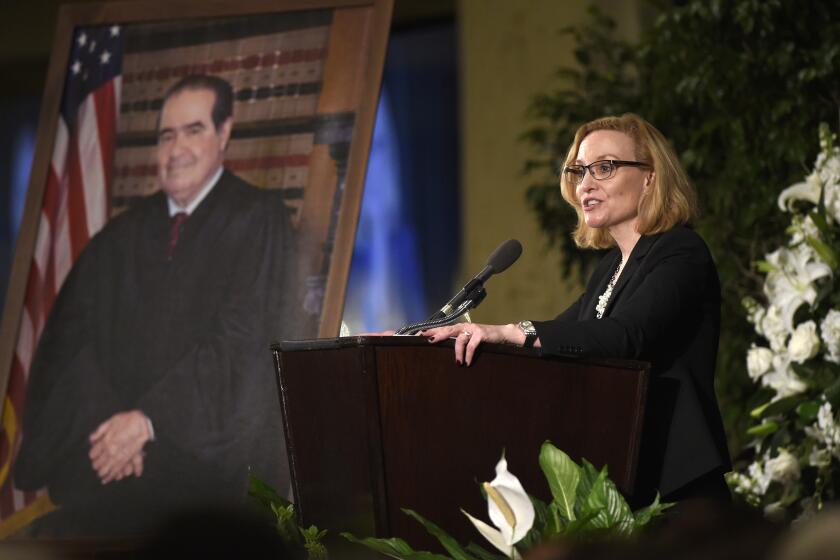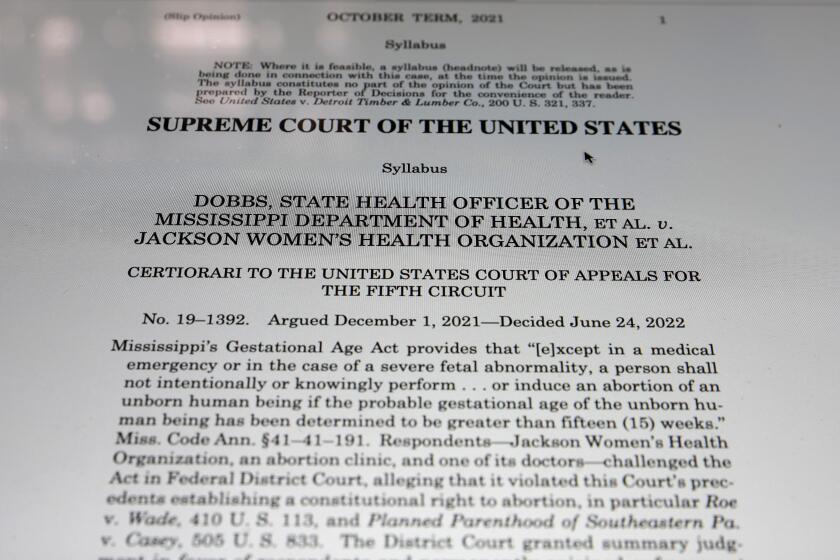In historic reversal, Supreme Court overturns Roe vs. Wade, permitting states to outlaw abortion

The Supreme Court has ended constitutional protections for abortion that had been in place nearly 50 years in a decision by its conservative majority to overturn Roe vs. Wade.
- Share via
WASHINGTON — In a historic reversal, the Supreme Court on Friday overturned the landmark 1973 Roe vs. Wade decision and ruled that states may again outlaw abortion.
The court’s conservative majority said the Constitution does not protect the right to abortion, instead leaving the decision in the hands of state lawmakers.
The 5-4 ruling marks the most significant curtailing of an established constitutional right in the court’s history.
The opinion written by Justice Samuel A. Alito Jr. closely tracks a draft that was leaked by Politico in May.
“We hold that Roe and [1992’s Planned Parenthood vs.] Casey must be overruled,” Alito wrote. “The Constitution makes no reference to abortion, and no such right is implicitly protected by any constitutional provision, including the one on which the defenders of Roe and Casey now chiefly rely — the Due Process Clause of the Fourteenth Amendment.”
The opinion was joined by Justices Clarence Thomas, Neil M. Gorsuch, Brett M. Kavanaugh and Amy Coney Barrett.
Roe vs. Wade went from ‘settled’ law to overruled in a few years, thanks to four unexpected developments.
Chief Justice John G. Roberts Jr. did not join the majority opinion in overturning Roe, saying he would have upheld only a Mississippi 15-week ban on abortion in the case that was before the court. His vote made for a 6-3 decision to uphold Mississippi’s law.
“The Court’s decision to overrule Roe and Casey is a serious jolt to the legal system,” Roberts wrote.
The court’s three liberal justices — Stephen G. Breyer, Sonia Sotomayor and Elena Kagan — dissented.
“Today, the Court ... says that from the very moment of fertilization, a woman has no rights to speak of,” their dissent read. “A State can force her to bring a pregnancy to term, even at the steepest personal and familial costs.”
The dissenting justices added, “Whatever the exact scope of the coming laws, one result of today’s decision is certain: the curtailment of women’s rights, and of their status as free and equal citizens.”
A look back at U.S. abortion laws and the Roe vs. Wade decision.
The ruling is expected to set off a fierce political fight nationwide and state by state as politicians and voters weigh in on whether abortion should be restricted or prohibited entirely.
The decision will almost certainly inject the abortion debate into the midterm election.
“This fall Roe is on the ballot,” President Biden said, calling on Congress to pass legislation restoring a nationwide right to abortion. “The health and life of women in this nation are now at risk.”
Conservatives, meanwhile, promised to push for abortion bans in every state or antiabortion legislation at the federal level, particularly if they make gains in Congress in November’s elections.
Former Vice President Mike Pence said social conservatives in the post-Roe era “must not rest and must not relent until the sanctity of life is restored to the center of American law in every state in the land.”
House Speaker Nancy Pelosi (D-San Francisco) called the court’s action “an insult.”
“It’s a slap in the face to women about using their own judgment to make their own decision about their reproductive freedom,” she said.
Opinion polls show most Americans support access to abortion, at least in the early months of a pregnancy. Nevertheless, half the states are expected to move quickly to enforce laws that make most abortions illegal.
The decision is the high court’s most far-reaching reversal on a matter of constitutional rights since 1954, when the justices reversed six decades of precedent and struck down laws authorizing racial segregation.
But that unanimous decision in Brown vs. Board of Education expanded the rights of individuals and rejected conservative state laws, while Friday’s majority ruling does the opposite. It empowers states and reverses the most significant women’s rights ruling in the court’s history.
For U.S. Catholic bishops as well as evangelical Christians who believe abortion ends a human life and is immoral, the ruling is a triumph decades in the making. They had refused to accept the idea that the Constitution protected abortion as a fundamental right.
Many conservative legal experts say the constitutional right to abortion — and particularly the Roe ruling — was always built on a shaky legal foundation, leaving it vulnerable.
Even the late Justice Ruth Bader Ginsburg, a champion of women’s rights, had criticized the 1973 opinion, saying it went too far too fast. She said the court should have built support for legalized abortion as a matter of equal rights for women.
Alito, who joined the Reagan administration as a young lawyer in the 1980s, said at the time that he looked forward to one day arguing for overturning Roe.
His 79-page opinion on Friday insisted that nothing in the language or history of the Constitution suggested it could be used to void state bans on abortion.
“Roe was on a collision course with the Constitution from the day it was decided,” he wrote, adding that more than half of the states had asked the court to overturn the decision. He said a right to abortion had never “been part of this nation’s tradition.”
Kavanaugh, who was narrowly confirmed in 2018 after assuring senators that he considered Roe to be “settled” law, said the court should now step away from deciding abortion cases.
“In my judgment, on the issue of abortion, the Constitution is neither pro-life nor pro-choice,” he wrote in a concurring decision. “The Constitution is neutral, and this Court likewise must be scrupulously neutral.”
He also said the abortion decision would not “affect other precedents involving issues such as contraception and marriage,” citing the 2015 decision upholding same-sex marriage. Overruling Roe “does not threaten or cast doubt on those precedents,” he wrote.
But in a separate concurring opinion, Thomas said the court should reconsider and overturn other decisions that created rights not spelled out in the Constitution. He cited the decisions the allowed contraceptives, gay sex and same-sex marriages.
None of the other justices joined him.
Kavanaugh shared his views on two other abortion-related questions that may reach the court.
“May a State bar a resident of that State from traveling to another State to obtain an abortion? In my view, the answer is no based on the constitutional right to interstate travel,” Kavanaugh said. “May a State retroactively impose liability or punishment for an abortion that occurred before today’s decision takes effect? In my view, the answer is no.”
The court’s action Friday left Roberts in an awkward position. He had once been a critic of abortion rights, but ultimately concluded it would be a mistake for the court to make an abrupt turn and reverse a major precedent.
“I would decide the question we granted review to answer — whether the previously recognized abortion right bars all abortion restrictions prior to viability, such that a ban on abortions after fifteen weeks of pregnancy is necessarily unlawful. The answer to that question is no, and there is no need to go further to decide this case. I therefore concur only in the judgment,” he wrote.
In a 60-page dissent, the three liberal justices made a powerful attack on the majority’s emphasis on the views of those who drafted the Constitution and amendments in an era when women had no voice and no vote.
Alito’s opinion focused on the 14th Amendment, adopted in 1868, and on what was understood as a fundamental liberty at that time.
“What rights did those ‘people’ have in their heads at the time?” the dissenters asked, referring to those who wrote and ratified the 14th Amendment. “But, of course, ‘people’ did not ratify the Fourteenth Amendment. Men did. So it is perhaps not so surprising that the ratifiers were not perfectly attuned to the importance of reproductive rights for women’s liberty, or for their capacity to participate as equal members of our nation.”
Those 19th century views should not dictate the rights of women in the 21st century, they said.
“Because laws in 1868 deprived women of any control over their bodies, the majority approves States doing so today. Because those laws prevented women from charting the course of their own lives, the majority says States can do the same again. Because in 1868, the government could tell a pregnant woman — even in the first days of her pregnancy — that she could do nothing but bear a child, it can once more impose that command,” they wrote.
By contrast, they said, the Roe and Casey decisions were “the product of a profound and ongoing change in women’s roles in the latter part of the 20th century.”
The court understood in 1992’s Casey ruling that for women “to take their place as full and equal citizens ... [they] must have control over their reproductive decisions,” they wrote.
Friday’s decision reflects a profound change within the court and the Republican Party.
When the court handed down the Roe vs. Wade ruling in 1973 and voided the abortion bans that were in effect in nearly all 50 states, the 7-2 majority included five Republican appointees. In 1992, when a divided court upheld the right to abortion, the five justices in the majority were Republican appointees.
But in recent decades, Republican presidents promised to select new justices who would overturn Roe.
With the help of Senate Republican leader Mitch McConnell, President Trump appointed three new justices who made the difference. The death of Ginsburg in September 2020 cleared the way for McConnell and his Republican majority to confirm Barrett a week before Trump was defeated in the November election. Her vote proved crucial to the outcome.
The prospect of a major change on abortion first became apparent in the summer of 2018.
Justice Anthony M. Kennedy, a likely swing vote on abortion, announced his retirement at age 82, clearing the way for Trump to appoint the more conservative Kavanaugh, Kennedy’s former clerk. After a fierce fight in the Senate, Kavanaugh was confirmed on a party-line vote.
Republican state attorneys saw an opening to change the law. In June 2020, Mississippi Atty. Gen. Lynn Fitch urged the court to review a proposed state law that limited abortions to the first 15 weeks of pregnancy.
The justices were set to consider the state’s appeal in Dobbs vs. Jackson Women’s Health Organization at their first conference of the new term on Sept. 29, 2020. But on Sept. 18, Ginsburg, the court’s senior liberal, died after a long battle with cancer.
Four days later, the Mississippi appeal was rescheduled for a future conference, and on May 17, 2021, the justices announced they would hear the case and decide “whether all pre-viability prohibitions on elective abortions were unconstitutional.”
More to Read
Get the L.A. Times Politics newsletter
Deeply reported insights into legislation, politics and policy from Sacramento, Washington and beyond. In your inbox twice per week.
You may occasionally receive promotional content from the Los Angeles Times.












